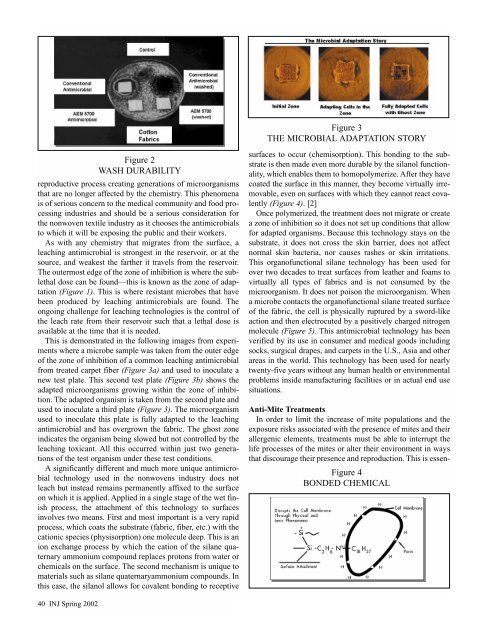2002 - Volume 1 - JEFF. Journal of Engineered Fibers and Fabrics
2002 - Volume 1 - JEFF. Journal of Engineered Fibers and Fabrics
2002 - Volume 1 - JEFF. Journal of Engineered Fibers and Fabrics
Create successful ePaper yourself
Turn your PDF publications into a flip-book with our unique Google optimized e-Paper software.
eproductive process creating generations <strong>of</strong> microorganisms<br />
that are no longer affected by the chemistry. This phenomena<br />
is <strong>of</strong> serious concern to the medical community <strong>and</strong> food processing<br />
industries <strong>and</strong> should be a serious consideration for<br />
the nonwoven textile industry as it chooses the antimicrobials<br />
to which it will be exposing the public <strong>and</strong> their workers.<br />
As with any chemistry that migrates from the surface, a<br />
leaching antimicrobial is strongest in the reservoir, or at the<br />
source, <strong>and</strong> weakest the farther it travels from the reservoir.<br />
The outermost edge <strong>of</strong> the zone <strong>of</strong> inhibition is where the sublethal<br />
dose can be found—this is known as the zone <strong>of</strong> adaptation<br />
(Figure 1). This is where resistant microbes that have<br />
been produced by leaching antimicrobials are found. The<br />
ongoing challenge for leaching technologies is the control <strong>of</strong><br />
the leach rate from their reservoir such that a lethal dose is<br />
available at the time that it is needed.<br />
This is demonstrated in the following images from experiments<br />
where a microbe sample was taken from the outer edge<br />
<strong>of</strong> the zone <strong>of</strong> inhibition <strong>of</strong> a common leaching antimicrobial<br />
from treated carpet fiber (Figure 3a) <strong>and</strong> used to inoculate a<br />
new test plate. This second test plate (Figure 3b) shows the<br />
adapted microorganisms growing within the zone <strong>of</strong> inhibition.<br />
The adapted organism is taken from the second plate <strong>and</strong><br />
used to inoculate a third plate (Figure 3). The microorganism<br />
used to inoculate this plate is fully adapted to the leaching<br />
antimicrobial <strong>and</strong> has overgrown the fabric. The ghost zone<br />
indicates the organism being slowed but not controlled by the<br />
leaching toxicant. All this occurred within just two generations<br />
<strong>of</strong> the test organism under these test conditions.<br />
A significantly different <strong>and</strong> much more unique antimicrobial<br />
technology used in the nonwovens industry does not<br />
leach but instead remains permanently affixed to the surface<br />
on which it is applied. Applied in a single stage <strong>of</strong> the wet finish<br />
process, the attachment <strong>of</strong> this technology to surfaces<br />
involves two means. First <strong>and</strong> most important is a very rapid<br />
process, which coats the substrate (fabric, fiber, etc.) with the<br />
cationic species (physisorption) one molecule deep. This is an<br />
ion exchange process by which the cation <strong>of</strong> the silane quaternary<br />
ammonium compound replaces protons from water or<br />
chemicals on the surface. The second mechanism is unique to<br />
materials such as silane quaternaryammonium compounds. In<br />
this case, the silanol allows for covalent bonding to receptive<br />
40 INJ Spring <strong>2002</strong><br />
Figure 2<br />
WASH DURABILITY<br />
Figure 3<br />
THE MICROBIAL ADAPTATION STORY<br />
surfaces to occur (chemisorption). This bonding to the substrate<br />
is then made even more durable by the silanol functionality,<br />
which enables them to homopolymerize. After they have<br />
coated the surface in this manner, they become virtually irremovable,<br />
even on surfaces with which they cannot react covalently<br />
(Figure 4). [2]<br />
Once polymerized, the treatment does not migrate or create<br />
a zone <strong>of</strong> inhibition so it does not set up conditions that allow<br />
for adapted organisms. Because this technology stays on the<br />
substrate, it does not cross the skin barrier, does not affect<br />
normal skin bacteria, nor causes rashes or skin irritations.<br />
This organ<strong>of</strong>unctional silane technology has been used for<br />
over two decades to treat surfaces from leather <strong>and</strong> foams to<br />
virtually all types <strong>of</strong> fabrics <strong>and</strong> is not consumed by the<br />
microorganism. It does not poison the microorganism. When<br />
a microbe contacts the organ<strong>of</strong>unctional silane treated surface<br />
<strong>of</strong> the fabric, the cell is physically ruptured by a sword-like<br />
action <strong>and</strong> then electrocuted by a positively charged nitrogen<br />
molecule (Figure 5). This antimicrobial technology has been<br />
verified by its use in consumer <strong>and</strong> medical goods including<br />
socks, surgical drapes, <strong>and</strong> carpets in the U.S., Asia <strong>and</strong> other<br />
areas in the world. This technology has been used for nearly<br />
twenty-five years without any human health or environmental<br />
problems inside manufacturing facilities or in actual end use<br />
situations.<br />
Anti-Mite Treatments<br />
In order to limit the increase <strong>of</strong> mite populations <strong>and</strong> the<br />
exposure risks associated with the presence <strong>of</strong> mites <strong>and</strong> their<br />
allergenic elements, treatments must be able to interrupt the<br />
life processes <strong>of</strong> the mites or alter their environment in ways<br />
that discourage their presence <strong>and</strong> reproduction. This is essen-<br />
Figure 4<br />
BONDED CHEMICAL

















